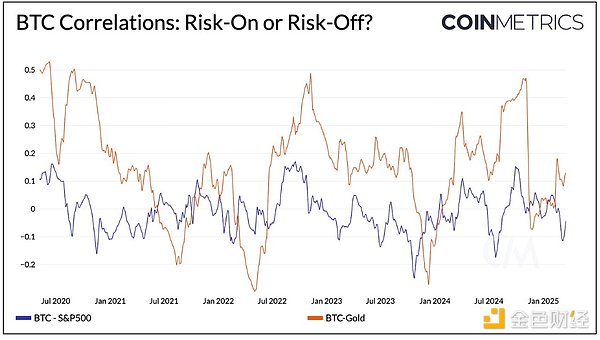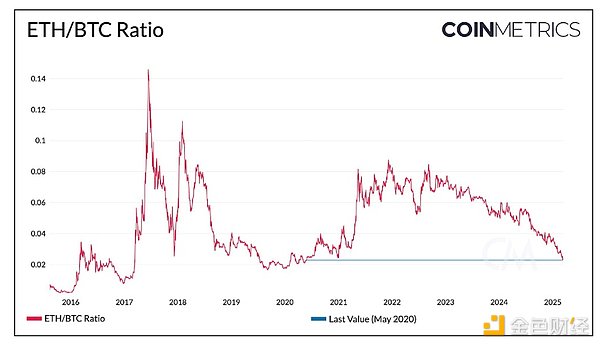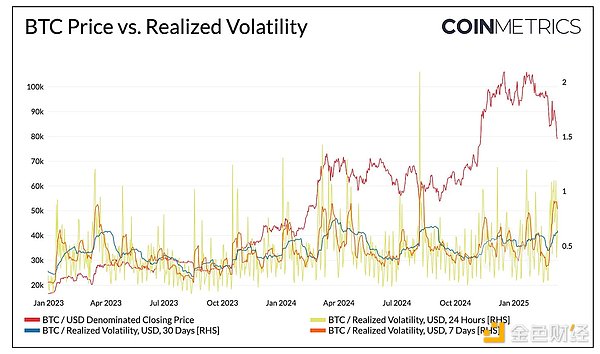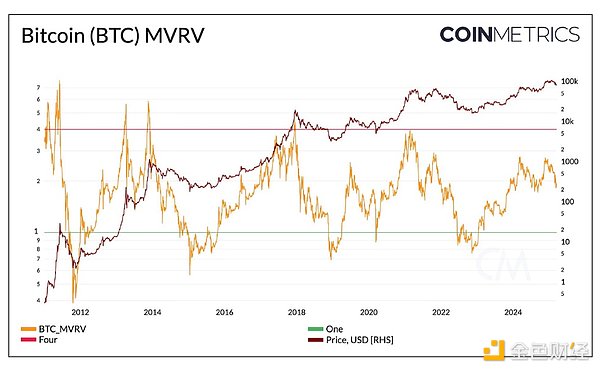Analysis of drivers of recent weakness in the crypto market and cyclical stage judgment

Reprinted from jinse
03/19/2025·2MAuthor: Tanay Ved, Coin Metrics analyst; translated by: Golden Finance xiaozou
summary:
-
The crypto market is suppressed by the double suppression of macroeconomic headwinds and industry-specific challenges, and volatility has once again intensified.
-
Bitcoin remains largely unrelated to traditional assets such as gold and the S&P 500, highlighting its unique positioning in the current macro environment.
-
Bitcoin’s dominance continues to rise, strengthening the market structure driven by institutional capital, while retail investors’ participation remains low.
-
Market conditions are still uncertain, but improvements in macro dynamics, clearness of regulation and changes in capital flows may lay a solid foundation for long-term market growth.
1. Introduction
Affected by waves of volatility and uncertainty, the digital asset market has been trapped in multiple influences of macroeconomic pressure and encryption- specific factors. Just a few weeks ago, BTC was still consolidating around $100,000, and market participants were optimistic about a new round of growth under higher-supported government and structural catalysts. Now, as BTC hovers around $80,000, market sentiment has changed significantly. Speculation has cooled down, Bybit’s hacking has exacerbated uneasiness and economic uncertainty has weakened risk appetite. However, there are still many positive developments, such as the establishment of US Bitcoin strategic reserves and the constructive transformation of regulatory methods in the crypto industry.
In this article, we will evaluate the drivers behind recent crypto market weakness and our position in the broader market cycle to jointly explore the macroeconomic and crypto-specific factors that shape the path to the future.
2. Macroeconomic factors dominate
The majority of stock markets and crypto assets have experienced turbulent months, leaving the post-election gains gone. The main driver of this volatility is the growing macroeconomic pressures manifested in Trump’s radical trade policies, retaliatory measures by major U.S. trading partners, and escalating geopolitical tensions – all of which have combined create environmental uncertainty and suppress inflation expectations and economic growth.
Despite seemingly positive developments, such as the establishment of a strategic Bitcoin reserve before the White House crypto summit, the withdrawal of high-profile lawsuits by the SEC and the growth of institutional momentum, macroeconomic headwinds and recent industry-specific challenges have kept the digital asset market under constant pressure.

In the current uncertain market environment, gold soared to above $3,000, and investors flocked to this primary safe-haven asset. Meanwhile, the S&P 500 and Nasdaq Composite Index fell 3.8% and 8.2% year-on-year, respectively, with risk appetite weakening. However, Bitcoin seems to be sandwiched between these two forces. Although often seen as a “digital gold” and a tool to hedge inflation or market instability, BTC has not yet established a meaningful correlation with gold, and its 90-day correlation with the S&P 500 and gold remains weak (approximately 0), pointing to its irrelevant and vague role in the current market mechanism.
3. Internal factors of the crypto market
(1) Are retail investors still there?
Although greater macro forces play a major role, the inherent dynamics of crypto assets continue to shape the market in unique ways. Bitcoin ( BTC ) remains the main market driver and the overall market risk appetite barometer. Bitcoin’s dominance, which measures its market value as a percentage of the entire crypto market, has steadily climbed from 37% in November 2022 to 61% today. While this is a characteristic of the past cycle, structural shifts such as the launch of spot Bitcoin ETFs and demand for company holders such as MicroStrategy have amplified this Bitcoin-powered market structure.
 The dominance of altcoins has approached 39%. Although the decline in
Bitcoin’s dominance has always signaled the rotation of funds to altcoins and
marked the beginning of the “altcoin season”, the reversal of the current
trend remains elusive. The continued weakness of altcoins may reflect a
growing division between institutional sentiment and retail sentiment, which
is also evident in spot trading volumes. Although altcoins generally find it
difficult to keep up, meme coins have become the preferred tool for retail
speculation. However, the recent cooling in the sector has further suppressed
retail sentiment.
The dominance of altcoins has approached 39%. Although the decline in
Bitcoin’s dominance has always signaled the rotation of funds to altcoins and
marked the beginning of the “altcoin season”, the reversal of the current
trend remains elusive. The continued weakness of altcoins may reflect a
growing division between institutional sentiment and retail sentiment, which
is also evident in spot trading volumes. Although altcoins generally find it
difficult to keep up, meme coins have become the preferred tool for retail
speculation. However, the recent cooling in the sector has further suppressed
retail sentiment.

(2) Poor ETH performance and altcoin differentiation
Another factor influencing is the continued poor performance of Ethereum (ETH) relative to Bitcoin (BTC). Changes in ETH/BTC have always been correlated with changes in altcoin dominance, and altcoin dominance rose when ETH/BTC weakness reversed in 2017, 2018 and 2021. The current ETH/BTC ratio is 0.022, which is at the level in May 2020.
While this underperformance can be attributed to Ethereum’s own challenges such as reduced L1 activity, value accumulation of L2 and competition from other L1s, it also suppresses widespread altcoin sentiment. The reversal of ETH/BTC, coupled with the improvement of macro prospects and regulatory clarity, could be a potential catalyst for altcoins, especially those with a stronger foundation and clearer investment themes in the field of structural growth.
3. Volatility increases, leverage resets
BTC is volatile. Although BTC's volatility has weakened over time, it is still prone to substantial declines and price volatility. Recently, we can see daily volatility rising, with BTC's 7-day volatility reaching 0.9 in a decline of about 25%.

This volatility has recently triggered a wave of liquidation in the spot and derivatives markets. However, the Bitcoin futures market shows that positions are healthier than they were a few months ago. Futures open contracts have dropped to pre-November election levels, indicating that excess leverage has been cleared. The proportion of futures open contracts relative to their market capitalization also declined, indicating that speculative positions have been reset. This provides a more stable foundation for the next stage of growth .
4. Our position in the cycle? What 's next?
Given the current environment, where do we lie relative to the previous "cycle"? Among many indicators, Bitcoin’s MVRV ratio (a ratio measuring Bitcoin’s market value to its realized value—the sum of the last transferred currency price on the chain—can be used as a useful indicator for cyclical positioning. Historically, high rates (>3.5) indicate market overheating, while low rates (1) indicate being in an attractive accumulation area.
Currently, Bitcoin’s MVRV ratio is 1.9, and this value reached a peak of nearly 2.65 at the beginning of this year. This puts its current position above the bear market lows but below the past cycle peaks, indicating that we are in the mid-term reset phase . While historical trends provide a useful framework, structural shifts such as ETF-driven demand, evolution of investor profiles, and regulatory clarity may reshape how this cycle develops and how we understand it relative to past cycles.

Looking ahead, the medium- and long-term prospects remain optimistic . Expectations for highly supported governments and SECs are being realized. Regulatory clarity in areas such as custody and banking participation, stablecoins and real-world assets (RWAs) tokenization may unleash a wave of massive adoption.
Although the macroeconomic outlook remains uncertain, the foundation has been laid, and as the structural shift takes effect, interest rate cuts and the start of a new round of liquidity may help drive market growth in the next phase.


 chaincatcher
chaincatcher
 panewslab
panewslab